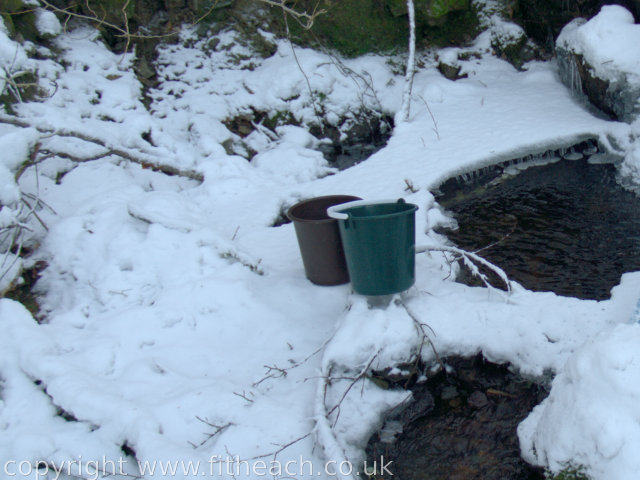The Mini Freeze
The Big Freeze seems to be over but now we seem to be having a Mini Freeze. During January (2010) there was a sustained period of very cold weather with a low of -23° centigrade (according to the car thermometer). Now, towards the end of February, we are having another cold spell although this time the temperature is only getting to about -15° centigrade.

In times of severe cold it is sometimes necessary to collect water using old methods.
The sustained nature of the cold has resulted in the burn, where our water supply comes from, being frozen solid. As we live many miles from the nearest public water supply all our water is sourced from the local burn. Water is collected from the burn by means of a pipe inserted into a small dam. The pipe then fills a large storage tank and finally the water is delivered to the house by an underground pipe.
The old ways
When the burn gets frozen you know you have a short time before the water in the tank runs out. Of course, if it is really cold the water in the storage tank freezes too and then the supply runs out immediately. If really cold winters were a regular occurence it would be worth insulating the storage tank. However, it would never be possible to stop the burn from freezing.
Getting water is then a matter of walking to the burn, breaking the ice where there is a deep pool and filling some buckets. At times like these you realise just how much water we use: drinking, cooking, washing, cleaning dishes and flushing toilets. When the system defrosts and taps can be used again you really appreciate the convenience. Of particular note is hot water: usually the water is heated by our Aga[1] however when the water is off everything needs to be heated in pans on the stove.
Pure Highland Water
Once the thaw comes, which it did for a short period in early February, the problems aren't over. When the burn comes cascading down the hillside it collects fragments of leaves, twigs, moss, peat and other stuff I'd rather not think about. Over time this detritus collects in the water storage tank and settles at the bottom.

Water from the tap! After emptying the water tank and then refilling sediment is dislodged.
When the water returns and flows into the tank all the sediment is disturbed. Then when you pour a glass of water, from the tap, you get something like the picture on the left. It is just a matter of time before eveything settles and you get a nice clear glass.
Although, it should be noted that our normal water colour is not what others expect. Public water supplies are normally highly filtered and usually have the addition of chlorine, which I find has an unpleasant smell, taste and makes the water look bluish. Our water has, what I consider to be, a natural smell and taste but does have a slight tinge of green, and sometimes, brown colour. The colour varies depending on time of year and the amount of rain but regardless our city-dwelling visitors often look askance when presented with a glass. Perhaps I won't show the photograph to our visitors.
Notes
1 The Aga Cooker is a stored-heat stove with hot-plates and ovens (and in our case heats water in a back boiler).